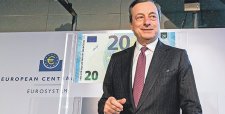Ainhoa Murga

The ECB president, Mario Draghi, estimates that the eurozone has finally found the road to recovery.
A six weeks to announce a definitive shift in monetary policy in the euro area, macroeconomic figures for January and February supported optimism yesterday with the president of the European Central Bank, Mario Draghi, He said the region has found the path to recovery.
It seems that spring (boreal) will end the long winter caused by six years of crisis in the region.
The financial and sovereign crisis has brought the eurozone economy at a lower level than it was when he collapsed US bank Lehman Brothers investment nearly seven years ago. Despite the geopolitical risk generated by tension and conflict with Greece on the eastern border of the European Union and the different pace at which the bloc’s economies perform, ECB economists believe that the euro zone can move beyond the impasse.
And the Eurostat’s flash estimate supports its positivism eurozone gross domestic product grew 0.3% annually in the last quarter of 2014, “above the estimate,” said Draghi
Best estimates
Following the monetary policy meeting held yesterday in Nicosia (Cyprus), the agency raised its growth estimates for the currency bloc 1.5 % in 2015 and 1.9% in 2016, a significant improvement over the projected three months ago. The bank also said 2017 growth of 2.1% is expected.
“Our monetary policy decisions and worked with some level of satisfaction, the governing council has recognized” said Draghi at the press conference after the meeting. “We see that the objectives are gradually fulfilled.”
For the economist at ING DiBa Bank, Carsten Brzeski, “has been the most positive and optimistic speech in a while. Words like ‘expand’ or ‘strengthening ‘have not been used in combination with the recovery in the eurozone has long “appropriated Financial Times.
The central bank revised downward the Consumer Price Index (CPI) this year to 0 %, reflecting the slump in oil prices. By 2016, however, revised its previous estimate upwards to 1.5%, relying on the impact of monetary policy. For 2017, the ECB believes that inflation reached 1.8%, in line with its goal of “close to but below 2%” annually.
The new ECB projections reflect “the favorable impact of lower oil prices, the weaker euro and the effect of recent monetary policy measure issuer “Draghi said, stressing that this is the last stimulus applied and that recovery is now up to other actors. This announcement was Italian banker to governments of the eurozone: it is necessary to execute the pending structural reforms, it depends on the solid recovery. It requires improvement in productivity and employment and to this end, “it is very important to implement structural reforms effectively and quickly to advance the economic recovery,” he said Draghi.
No surprise for the experts, the Governing Council of the ECB decided to keep the 0.05% interest rate on the main financing operations, the level that remains since September last year. Likewise, kept unchanged rate on the marginal lending facility and the deposit facility at 0.30% and -0.20% respectively type.
Start of QE
Limited by low interest rates at historically low levels, European issuer in late January announced a program to purchase debt inject the financial system until September next year over 1,000,000,000,000 (trillion) euros to stimulate the economy and achieve the desired rise in inflation.
The ECB plan, which will start next Monday despite fierce resistance from Germany, pursues ” rebound in inflation “and, said Draghi,” already noted a significant number of positive effects, “highlighting the improvement in financing conditions for businesses and households.
The market expected with special interest yesterday’s meeting, because the body would reveal more details of this plan of quantitative easing (QE, its acronym in English). Since announcing the QE, demand for sovereign debt has soared by lowering their profitability to record lows in the case of Italy, Spain and Portugal this week, and the euro has fallen to lows of eleven against the dollar.
The ECB confirmed that the purchase program debt could extend beyond September 2016, if they believe has not been achieved sustainable inflation adjustment.
On the other hand, indicated that the range of instruments covering the stimulus program could reach negative performance bonds limit the rate of deposit facility; ie will not buy securities underperformed -0.2%
Bank of England. 6 years without changing the interest rate
Six years after implantation, the Bank of England (BoE, its acronym in English) decided yesterday to keep its benchmark interest rate at 0.5%, the level at which it has remained since the peak of the financial crisis.
This month the British broadcaster was adjusted to what economists expected, although the improvement of the economy suggests that it might start raising policy rates in the coming months, but none of economists polled by Reuters expected to choose change the direction of its monetary policy before the national elections on May 7.
Experts say, however, that low inflation sheds signs that the decision should occur sooner rather than later. The institution also changed its asset purchase program, which has allocated 375,000 million pounds (more than US $ 571 billion)
.
No comments:
Post a Comment